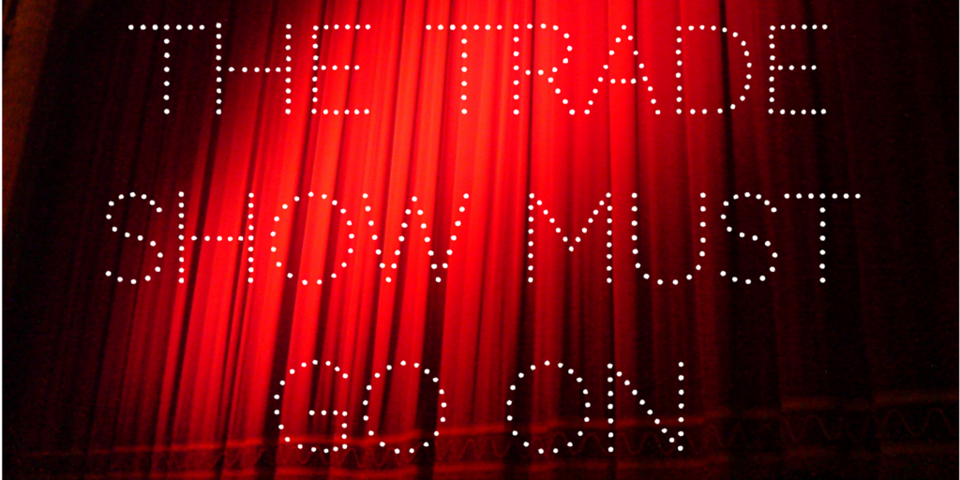The Trade Show Must Go On - Here’s How You Can Make It Great

Posted By Kathy Wilson on May 08, 2015
Companies ante up big marketing dollars for the opportunity to participate in top trade shows and conferences. But once the booth space is secured and your conference theme is developed, all eyes typically turn to the public relations/social media team for strategies on how to meaningfully extend the value of that investment.
Here are three key strategies with important reminders to help your organization, whether you're a startup or an industry giant, rise above the noise and capture valuable trade show mindshare.
Realistically Assess the Situation, and Plan Your Strategies Accordingly
It's critical to first assess the landscape for each particular event. A startup or emerging organization may be well-advised to steer clear of strategies like making a major announcement at a busy trade show dominated by major brands, such as a Consumer Electronics Show or Mobile World Congress. That doesn't mean smaller organizations can't effectively participate in these sorts of events. It just means your competition for media attention is just that much greater, and you need to plan accordingly.
For mega-events where you fear you may be lost in the noise, consider an advance campaign to pre-brief your industry analyst and media targets, and use the show as an opportunity to catch anyone you may have missed during the pre-briefs.
Think, too, about releasing your news in the week or two leading up to the event, not on day one of the show. This way your media coverage hits in advance of the show to drive interest and traffic to your booth.
In addition to announcing your news via a press release on a newswire service, don't forget the power of social media as a tool to promote what attendees will see at your booth. Be sure to promote the hashtag symbol for the event (or even create your own) in all your content, and encourage followers to follow along for live updates from the event. If you have the resources to live-tweet the event, it can be a great way to attract an audience of those who couldn't make it to the conference.
Many events, like Mobile World Congress, also create robust show websites that give attendees an opportunity to share perspectives on industry trends in the months leading up to the event. Posting content to these sites enables your organization to participate in the dialogue on a level playing field with the big boys, and establish itself as a knowledgeable (and visionary) resource.
Assess Your Show News and Home In on Your Targets
What does your organization plan to showcase at the conference? Are you announcing a new product/service? Rolling out new messaging? Talking up an important new partner relationship? Look for ways to make your story bigger by connecting the dots between your announcement and larger industry trends that are sure to be discussed at the event.
If you're exhibiting at the event, request the pre-registered media list so you can work to schedule briefings at your booth with the appropriate reporters and analysts (if you didn't already pre-brief them). Or if you're not exhibiting and don't have access to the pre-registered list, but still plan to attend an event and schedule a meeting or two while you're there, take a look at which publications/reporters ran coverage last year. Chances are that research will give you a good starting point for whom to call.
You'll also want to identify opportunities in show dailies – either event-sponsored or industry publications that will publish daily recaps during an event. Reach out to these publication contacts well in advance to understand their deadlines and share your news.
What about show awards? If you've got a new product or service, look for show-sponsored awards to enter. Winning these will not only give you bragging rights during an event, but most likely result in coverage in the show daily, too.
You'll also want to develop a social content calendar that maps out a variety of content in support of your announcements and overall conference theme that you can be pushing out on a daily basis. And since you'll be busy during the event itself, keep in mind tools like Hootsuite that provide a way to preload content and push out on a scheduled basis.
It Doesn't All Happen on the Show Floor
Can you host an invitation-only cocktail party or dinner for key customers and prospects at a nearby venue? Invite a provocative speaker to give a breakfast presentation at a major hotel prior to show opening hours? Offer company-sponsored bus service between hotels and the conference center to help ease long taxi lines, while building some brand awareness and goodwill? Position a coffee or ice cream kiosk adjacent to the conference center to give some sustenance to tired show attendees?
Think creatively about how you can extend your presence at a conference beyond the four walls of the conference hall – but be respectful of any related policies show management may have.
Trade shows can be costly, chaotic and exhausting. But they also offer unique opportunities for your organization to drive leads, build relationships with important influencers, and stand out from the pack with a disciplined approach and a little creativity. When so much business interaction today takes place virtually, trade shows afford a rare chance to offer an in-person, hands-on experience with your brand -- so making the most of it is more than just for good show.

Kathy Wilson
Kathy Wilson is a Co-founder and Managing Partner at Tier One, where she leads the agency's Boston office and serves as a strategic client counselor. She taps her three decades of experience in B2B and B2C technology, digital healthcare, and financial services — including work counseling major brands like SAP, Citrix, Ultimate Software, GHX, and Ally Financial — to help clients meet critical business and marketing objectives. Kathy is a die-hard Red Sox fan and loves nothing better than a summer day at Fenway Park.


